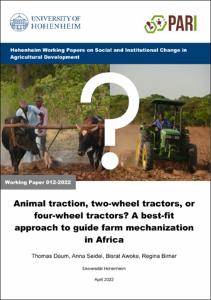Daum, Thomas; Seidel, Anna; Awoke, Bisrat; Birner, Regina: Animal traction, two-wheel tractors, or four-wheel tractors? A best-fit approach to guide farm mechanization in Africa. Hohenheim: University of Hohenheim, 2022. In: Hohenheim Working Papers on Social and Institutional Change in Agricultural Development, 012-2022.
Online-Ausgabe in bonndoc: https://hdl.handle.net/20.500.11811/11027
Online-Ausgabe in bonndoc: https://hdl.handle.net/20.500.11811/11027
@techreport{handle:20.500.11811/11027,
author = {{Thomas Daum} and {Anna Seidel} and {Bisrat Awoke} and {Regina Birner}},
title = {Animal traction, two-wheel tractors, or four-wheel tractors? A best-fit approach to guide farm mechanization in Africa},
publisher = {University of Hohenheim},
year = 2022,
month = apr,
series = {Hohenheim Working Papers on Social and Institutional Change in Agricultural Development},
volume = 012-2022,
note = {There are heavy - at times dogmatic - debates on which technological pathway toward farm mechanization - animal traction, two-wheel tractors, four-wheel tractors - should be supported by African governments and development partners. One discussion area relates to the future of animal traction. Proponents see a continued scope for the use of draught animals, whereas opponents see animal traction as old-fashioned and see a potential to leapfrog this mechanization stage. There are also debates on the potential of two-wheel tractors, with proponents arguing that such walk-behind tractors are more affordable and suitable for smallholder farmers, and opponents believing that such tractors lack efficiency and power and still come with a high drudgery. This paper argues that there are no blueprint answers on which technological pathway is “best” but only answers on which one “best fits” the respective conditions. Based on this premise, the paper introduces a “best fit” framework that allows for assessing the comparative advantages and disadvantages of the three technological pathways in different agro-ecological and socio-economic conditions. The results suggest that all three forms of mechanization are associated with areas where they “best fit”. All three farm mechanization pathways hinge on public policies and investments to create an enabling environment for private markets, as ultimately, innovation processes should be market-driven. The “best-fit” framework enables governments and development partners to focus efforts to support farm mechanization on solutions that “best fit” their country's farming systems and not on those that are politically most attractive.},
url = {https://hdl.handle.net/20.500.11811/11027}
}
author = {{Thomas Daum} and {Anna Seidel} and {Bisrat Awoke} and {Regina Birner}},
title = {Animal traction, two-wheel tractors, or four-wheel tractors? A best-fit approach to guide farm mechanization in Africa},
publisher = {University of Hohenheim},
year = 2022,
month = apr,
series = {Hohenheim Working Papers on Social and Institutional Change in Agricultural Development},
volume = 012-2022,
note = {There are heavy - at times dogmatic - debates on which technological pathway toward farm mechanization - animal traction, two-wheel tractors, four-wheel tractors - should be supported by African governments and development partners. One discussion area relates to the future of animal traction. Proponents see a continued scope for the use of draught animals, whereas opponents see animal traction as old-fashioned and see a potential to leapfrog this mechanization stage. There are also debates on the potential of two-wheel tractors, with proponents arguing that such walk-behind tractors are more affordable and suitable for smallholder farmers, and opponents believing that such tractors lack efficiency and power and still come with a high drudgery. This paper argues that there are no blueprint answers on which technological pathway is “best” but only answers on which one “best fits” the respective conditions. Based on this premise, the paper introduces a “best fit” framework that allows for assessing the comparative advantages and disadvantages of the three technological pathways in different agro-ecological and socio-economic conditions. The results suggest that all three forms of mechanization are associated with areas where they “best fit”. All three farm mechanization pathways hinge on public policies and investments to create an enabling environment for private markets, as ultimately, innovation processes should be market-driven. The “best-fit” framework enables governments and development partners to focus efforts to support farm mechanization on solutions that “best fit” their country's farming systems and not on those that are politically most attractive.},
url = {https://hdl.handle.net/20.500.11811/11027}
}






